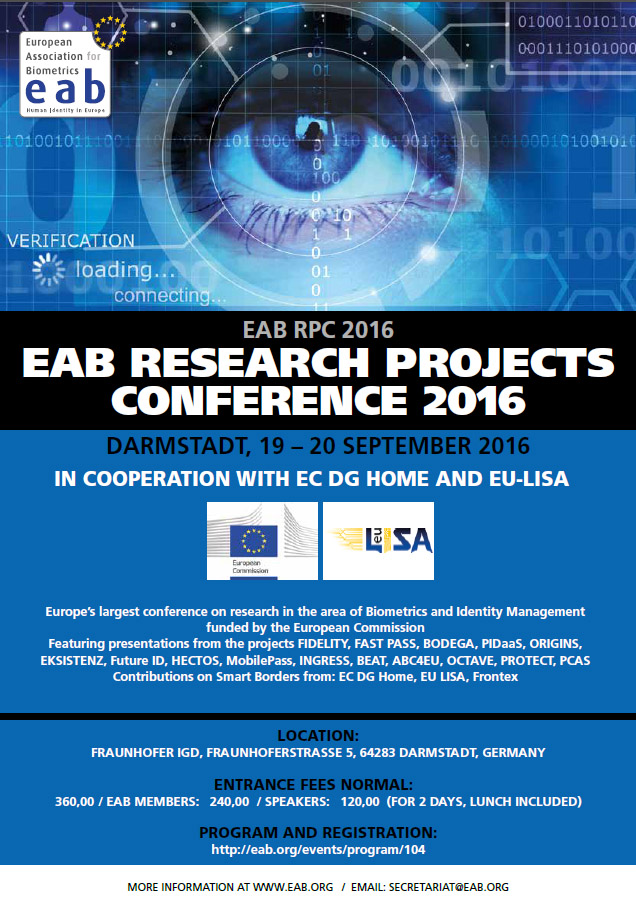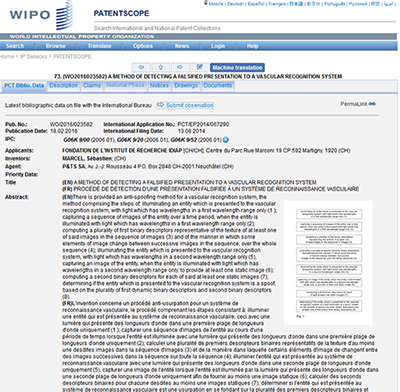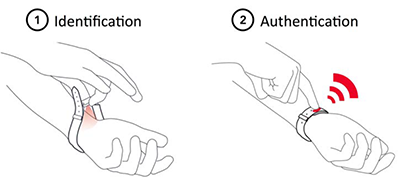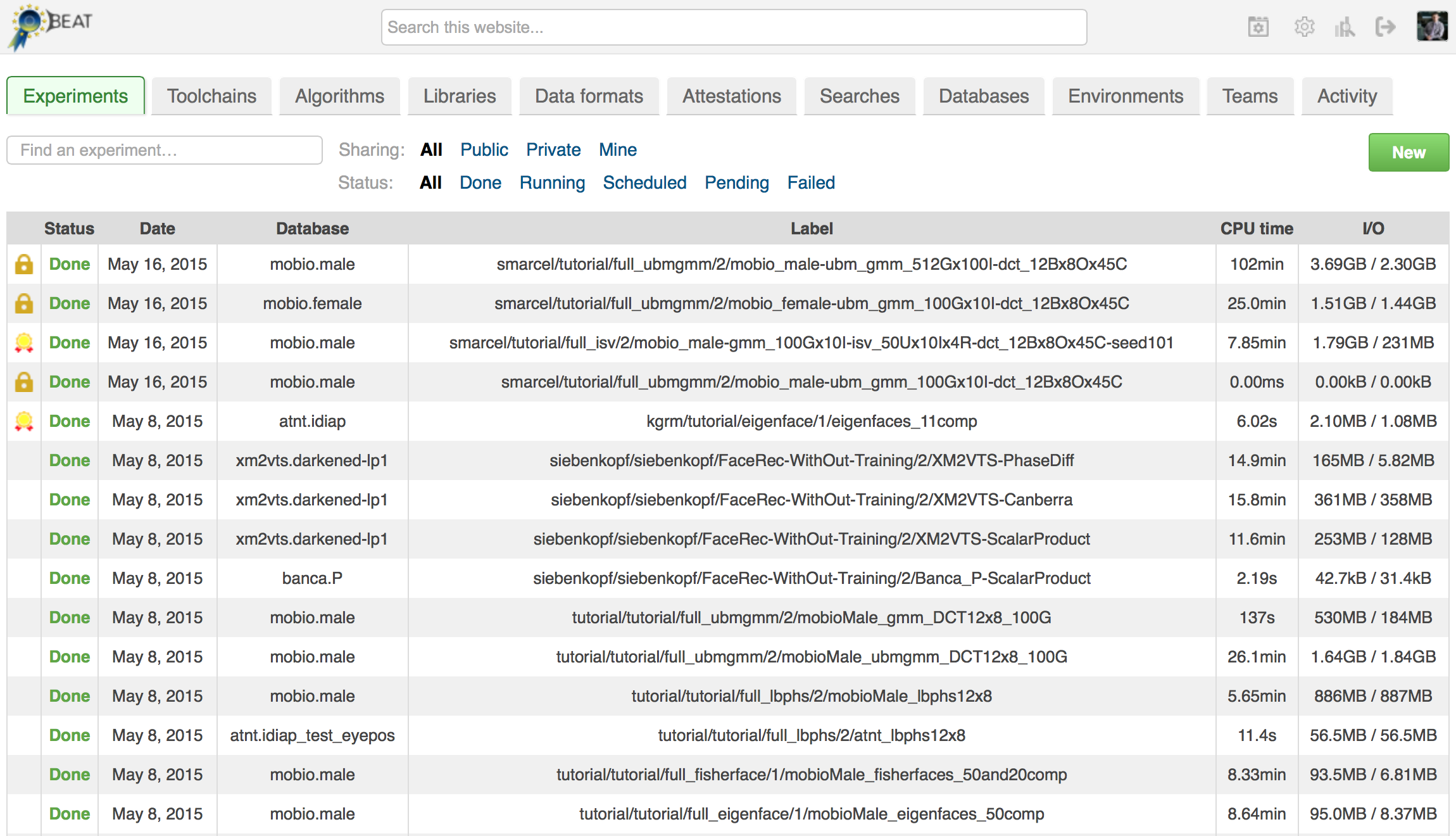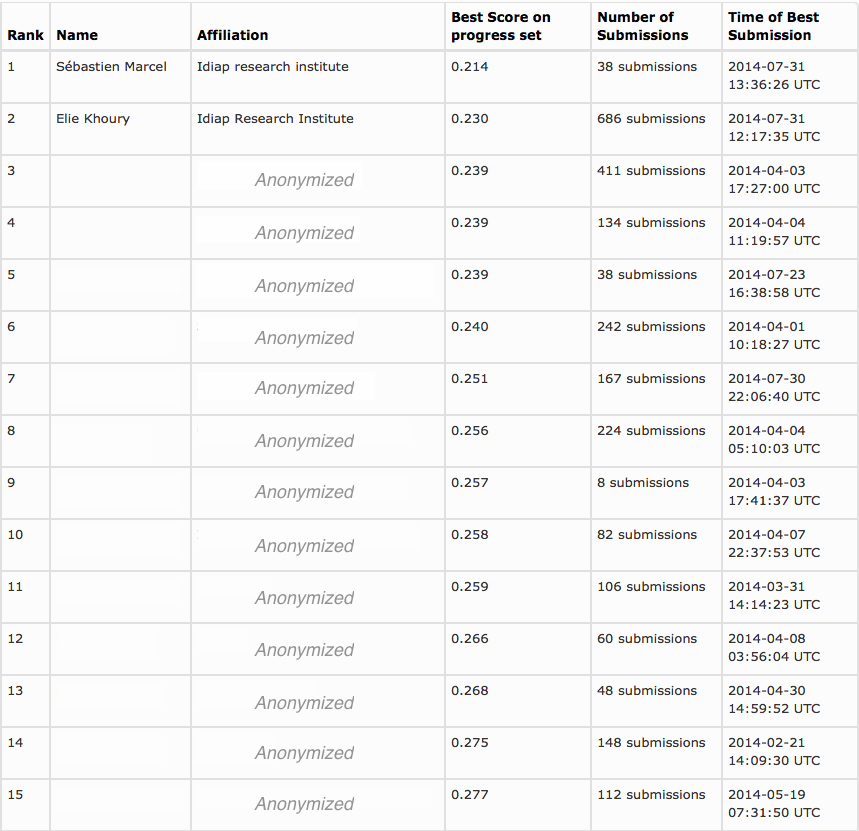Biometrics Evaluation and Testing (BEAT)
An Open-Source Web-Based Open-Science Platform
With the increased interest in computational sciences, machine learning (ML), pattern recognition (PR) and big data, governmental agencies, academia and manufacturers are overwhelmed by the constant influx of new algorithms and techniques promising improved performance, generalization and robustness. Sadly, result reproducibility is often an overlooked feature accompanying original research publications, competitions and benchmark evaluations.
To bridge this gap, the Idiap Research Institute built an open platform for research in computational sciences related to pattern recognition and machine learning, to help on the development, reproducibility and certification of results obtained in the field. By making use of such a system, academic, governmental or industrial organisations enable users to easily and socially develop processing toolchains, re-use data, algorithms, workflows and compare results from distinct algorithms and/or parameterizations with minimal effort.
The paper is publicly available here: An Open-Source Web-Based Open-Science Platform
The BEAT platform is operational here: BEAT Platform
Idiap signs a new research agreement with BBC on voice biometrics
The group developed the Spear open source speaker recognition toolkit on the top of its signal processing and machine learning framework Bob.
Dr Sébastien Marcel the head of the biometrics security & privacy group says « this is a great opportunity to evaluate the performance of our speaker recognition technologies on unique audio-visual archives such as the one from BBC».
Biometrics and Cybersecurity: The Idiap Research Institute as a Key Player
The institute’s growing reputation thanks to its biometrics research group and its Swiss Center for Biometrics Research and Testing, led by Dr Sébastien Marcel, can be measured by its recent successes. Indeed, Google has chosen Idiap as the only European partner within the framework of an exclusive research project. Also, in the context of spoofing attacks, IARPA, the American Intelligence Advanced Research Projects Activity, has taken Idiap research as inspiration.
Numerous active research projects
In Switzerland, the Commission for Technology and Innovation (CTI) trusted Idiap and its partners (CSEM, HES-SO Valais, BioWatch, KeyLemon and IT Services) and funds 3 new research projects on vein and face biometrics.
In Norway, the Research Council funds a project of 4 years on mobile biometrics (face, voice, iris and fingerprints) for banking applications.
In the United States, the Defense Advanced Research Projects Agency (DARPA) has allowed Idiap to participate in a project of the program « Media Forensics » that aims to detect manipulations of audio and video sources.
The Swiss Center for Biometrics Research and Testing and its BEAT platform at the heart of the ecosystem
All the innovative projects listed above require capturing new biometric data for research and evaluation purposes. Idiap, in collaboration with is partners, has launched an ambitious program to collect multimodal biometrics data (face, voice, vein, iris and fingerprints) from volunteers over the range of 2 years. Data will be anonymous, secured and available for research and evaluation, in particular thanks to the BEAT platform, co-developed by the Swiss Center for Biometrics Research and Testing and backed by the Canton of Valais and the City of Martigny. This platform, unique in its kind, is of growing interest for international actors active in this biometrics cyber-security and computational science in general.
EAB RESEARCH PROJECTS CONFERENCE (EAB-RPC) 2016
The EAB and EU-projects in the field like FIDELITY, FastPass, BEAT, Future-ID, INGRESS, PIDaaS, ABC4EU are jointly organizing a Research Project Conference (EAB-RPC), to present research results and in order to discuss the benefit of this research for our European society.
The BEAT platform goes Open Source
It is composed of 6 packages which can be reached on this gitlab group repository, hosted at Idiap ( https://gitlab.idiap.ch/beat ).
The BEAT platform is a European computing e-infrastructure for Open Science proposing a solution for open access, scientific information sharing and re-use including data and source code while protecting privacy and confidentiality. It allows easy online access to experimentation and testing in computational science. You define what data and modules you would like to use, we make sure the system runs and provides you with a result. Data from different experiments can be easily compared and searched. The platform also provides an attestation mechanism for your reports (scientific papers, technical documents or certifications).
New patent on vein anti-spoofing (PAD)
Your complete ID on your wrist thanks to BIOWATCH, Idiap and CSEM
The flagship product of BIOWATCH is a biometric identification system integrated into the buckle of a watchband that enables the secure authentication of a person by detecting the unique pattern of veins on the wrist. Numerous applications are possible, from bank card payments to opening a vehicle to replacing the passwords used every day on a computer.
For more information, please consult the press release here BIOWATCH .
License agreement signed between Idiap & EC’s Joint Research Center to experiment BEAT platform.
The platform can be used for biometric testing and performance characterization of biometric systems.
Sébastien Marcel the coordinator of the BEAT project at Idiap says « We are excited by this first licence agreement and to have such an institution like JRC to test and possibly deploy our BEAT platform on their data ».
The Who’s who of biometrical standards meets up at Idiap from January 11-19, 2016
The Idiap Research Institute and the Swiss Center for Biometrics Research and Testing, co-founded by Idiap, the canton of Valais and the city of Martigny, will welcome - for the first time - , from January 11-19, the international delegations of ISO standards in the field of biometrics (www.biometrics-center.ch/jtc1-sc37-martigny2015).
The aim of this meeting? Discussions and defining the future agenda in the domain of biometric standardization. More than 80 experts of biometrics coming from all four corners of the globe are expected, especially researchers, engineers and stakeholders of different governments.
The ISO (International Organization for Standardization) is an organism developing international standards used in the industrial and commercial sectors. Being composed of 162 member countries, it is the biggest standardization organization in the world. The goal of this institution is to make sure that products observing the ISO standards are secure, reliable and of good quality.
This meeting is concerned above all else with the improvement of standards in the field of biometrics related to the security of technologies. The objective is obviously to transfer these technologies to the industrial domain. Biometrics will play a big role in the future, especially in terms of security.
The following subjects will be treated during this week: the harmonization of the biometrics vocabulary; technical biometrics interfaces; the exchange formats of biometric data; the technical implementation of biometric systems; biometric test and reports for performance certifications.
The organization of these days is sponsored by the Idiap Research Institute, the Swiss Center of Biometrics Research and Testing, the Swiss Association for Standardization (SNV), the European Association for Biometrics (EAB) and the Hasler Foundation.
Sébastien Marcel, Idiap researcher and in charge of the management committee of the Swiss Center of Biometrics Research and Testing, declares: « We are honored to have been chosen to welcome the ISO working groups of biometrics. This is proof of the international recognition of our work in biometrics and the visibility created by the Center. It is also a success for the city of Martigny and the canton of Valais that support the development of the technological Valais.”
The Idiap Research Institute provides an European computing e-infrastructure for Open Science
It allows easy online access to experimentation and testing in computational science. You define what data and modules you would like to use, we make sure the system runs and provides you with a result. Data from different experiments can be easily compared and searched.
The platform also provides an attestation mechanism for your reports (scientific papers, technical documents or certifications).
The fight against identity theft
The research project Secure Access Control Over Wide Area Network (SWAN), is a project funded by The Research Council of Norway. The SWAN-project will research and develop innovative technologies and countermeasures to mitigate presentation attacks (also coined as spoofing attacks), which lead to a usable, economic, and privacy-preserving access control platform based on biometrics.
On 2nd November the Kick-Off meeting of the SWAN-project was held at Gjøvik University College. The project has 6 partners from Norway, Germany, France and Switzerland and is truly an European research project Gjøvik University College (nislab.no/biometrics_lab) as the coordinator of the project, is working closely with its partners University of Oslo (//folk.uio.no/josang), Idiap Research Institute in Switzerland (www.idiap.ch/biometrics), Safran Morpho (www.morpho.com) and Zwipe (www.zwipe.com). The group assembles standing experience in identity and biometrics research and more particularly in mobile face and speaker recognition as well as in presentation attack detection (aka anti-spoofing). The team is supported by end users from the financial sector and the Association of German Banks.
The Password-based approach is vulnerable, and crime related to illegal access to different accounts is easier than ever because of password used as authentication factor, says Professor Christoph Busch at Gjøvik University College. The research will initially deal with banking transactions, but the goal is to extend the technology to other e-services such as e-health.
Biometric references will be stored, controlled and verified locally based on a pre-shared secret, which can be used to seal and authenticate transaction data. This overcomes the need of centralized storage of biometric data. Smartphones will act as hardware tokens to which the additional functionalities will be integrated to capture the biometric characteristics like (face, fingerprint, voice and eye). Focus of the research project will be biometric authentication to preserve privacy and adapt existing and emerging standards in the field.
Read more: nislab.no/biometrics_lab/swan
New biometric databases for palm-vein identification and anti-spoofing
The Idiap Research Institute and Haute Ecole Spécialisée de Suisse Occidentale, Switzerland, just released the VERA palm-vein and VERA spoofing palm-vein databases.
These database are shared with the research community to improve the security of biometric systems as it was shown recently that both finger-vein and palm-vein biometric systems could be vulnerable to spoofing attacks under particular conditions.
The vulnerability to spoofing of palm-vein recognition is shown and discussed in the following paper that will be presented during the next International Conference on Biometrics (ICB) in May 2015:
"On the Vulnerability of Palm Vein Recognition to Spoofing Attacks" P. Tome and S. Marcel
Automatic Face and Gesture Recognition tutorial on the BEAT platform
(FG 2015 www.fg2015.org )
BEAT: An online web-platform for reproducible research
This tutorial will present the BEAT platform for online reproducible research, introducing concepts and providing an initial hands-on experience. The BEAT platform allows novice and advanced researchers to: (1) benchmark systems and components; (2) run comparative evaluations; (3) attest (certify) toolchains; (4) provide educational material for new-comers in pattern recognition and (5) optimize algorithms and systems. All these tasks can be accomplished without installing additional software on the users computer, running exclusively from the web browser. The BEAT platform naturally enforces important research aspects such as reproducibility and component re-use.
Program:
Required prior knowledge:
The target participants for this tutorial include both beginners and advanced researchers of any computer vision field with an interest towards reproducibility, experiment longevity and software re-use. We'll examplify our system and propose a simple tutorial using face recognition - interest on this area can be a plus. Other workflows and algorithms will be shown for different tasks in image processing.
New Idiap biometrics applications is born!
Most of the technologies for finger-vein capture are based on a transmission technique of Near-Infrared Light (NIR), while the developed prototype is based on a reflexion technique using an innovative configuration of NIR illumination.
This work was jointly funded by the European project FP7 BEAT, the HES-SO project VERA and the Swiss Center for Biometrics Research and Testing.
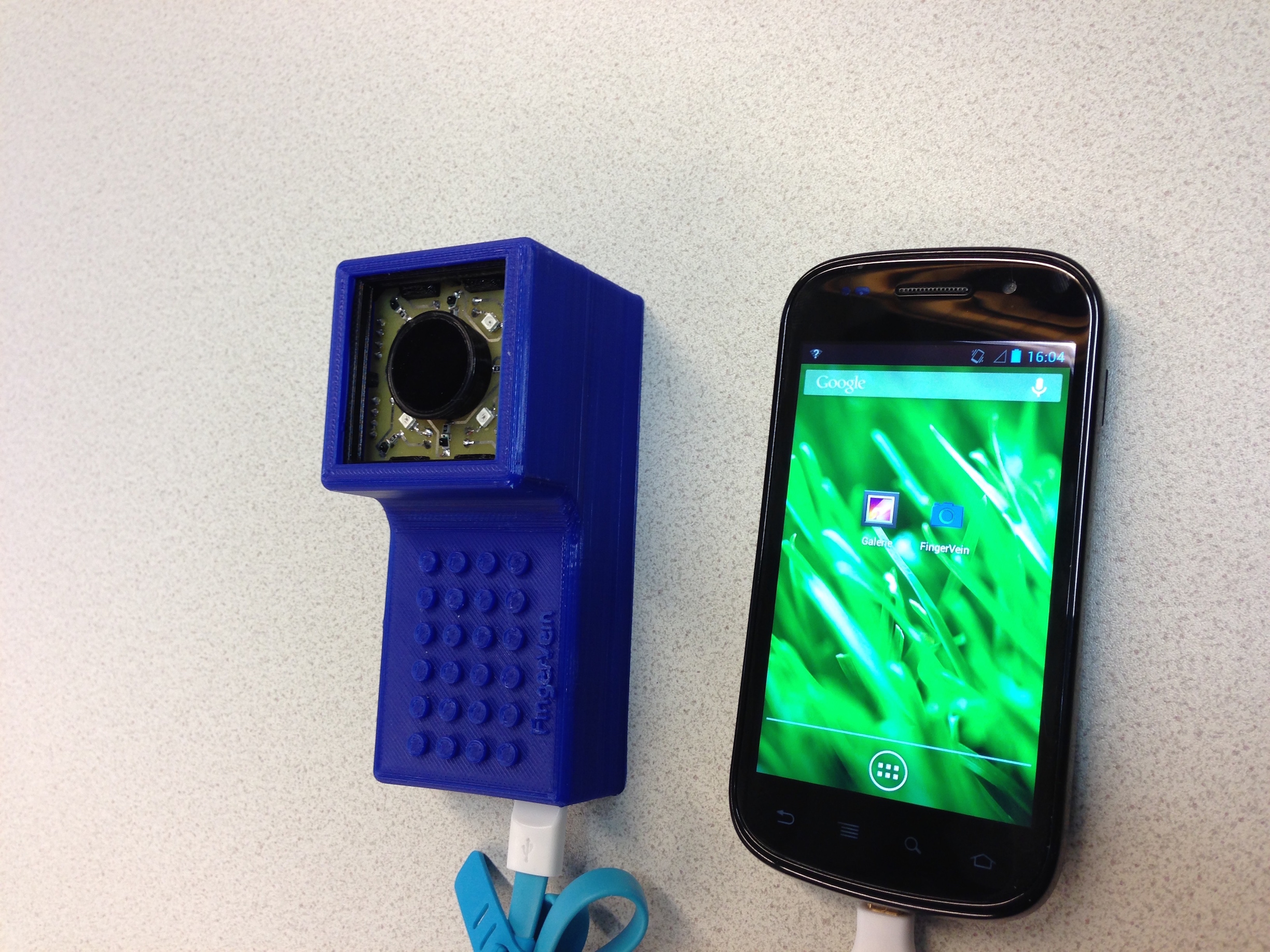
Swiss researchers from the Idiap research institute succeeded to spoof a commercial finger vein device
The Idiap research institute ranked 1st to the NIST i-Vector challenge on Speaker Recognition
Following its successful participation to the NIST Speaker Recognition Evaluation in 2012, the Biometric group of the Idiap research institute participated to the i-vector challenge that started beginning of December 2013. This challenge relies on the i-vector paradigm, which is the current state-of-the-art front-end for speaker recognition systems.
In total, more than 9000 systems were submitted and evaluated by NIST. Preliminary results of this challenge were presented at the special session during "Odyssey 2014: The Speaker and Language Recognition Workshop" that took place in June 2014.
Biometric vein recognition under attack
More information :
planetbiometrics.com/article-details/i/2012/
Direct link to the video:
www.youtube.com/watch?v=zxb9xwaoeTU
Fujitsu's palm-scanning laptops won't be fooled by severed limbs
 For all the popularity of fingerprint scanners, Fujitsu believes that it can go one better. The Japanese company has been working on palm-based systems for the last few years, and we've already seen turnstiles, wallets and tablets that are accessed from your hand. Fujitsu believes that palm vein sensing is around a thousand times more secure than conventional biometric methods and it's implementing the technology in its next range of business-focused laptops due out this week. We've been shown around some of these models, which have the new sensor fitted into an area that is roughly the same size and position as the company's existing fingerprint scanners, just below the bottom right corner of the keyboard. Using it is simple: Hold your hand a few inches above the sensor and the hardware will quickly scan the unique arrangement of your veins. If it judges you to be the real deal, it'll open up its secrets for your enjoyment.
For all the popularity of fingerprint scanners, Fujitsu believes that it can go one better. The Japanese company has been working on palm-based systems for the last few years, and we've already seen turnstiles, wallets and tablets that are accessed from your hand. Fujitsu believes that palm vein sensing is around a thousand times more secure than conventional biometric methods and it's implementing the technology in its next range of business-focused laptops due out this week. We've been shown around some of these models, which have the new sensor fitted into an area that is roughly the same size and position as the company's existing fingerprint scanners, just below the bottom right corner of the keyboard. Using it is simple: Hold your hand a few inches above the sensor and the hardware will quickly scan the unique arrangement of your veins. If it judges you to be the real deal, it'll open up its secrets for your enjoyment.
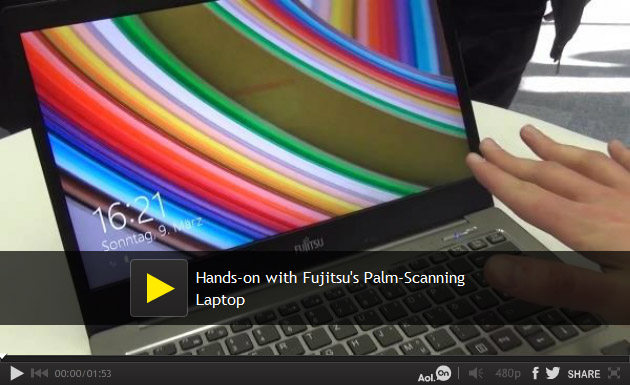 Of course, your biggest objection to that would be that, if some nefarious type wanted to get at your Amazon account, all they'd have to do is grab a sword and lop off your hand, right? Turns out, biology has provided us all with a built-in failsafe. Fujitsu's technology only works while blood is flowing through your veins, so your lifeless limb can't be used to breach the wall. Having seen this technology in action, we're reasonably sure that it's ready for prime-time, and we're excited to see if this as fool-proof as Fujitsu claims. Even if it is, however, the easiest and least messy way to access someone else's login will always be to ask them -- an approach that worked just fine for Edward Snowden.
Of course, your biggest objection to that would be that, if some nefarious type wanted to get at your Amazon account, all they'd have to do is grab a sword and lop off your hand, right? Turns out, biology has provided us all with a built-in failsafe. Fujitsu's technology only works while blood is flowing through your veins, so your lifeless limb can't be used to breach the wall. Having seen this technology in action, we're reasonably sure that it's ready for prime-time, and we're excited to see if this as fool-proof as Fujitsu claims. Even if it is, however, the easiest and least messy way to access someone else's login will always be to ask them -- an approach that worked just fine for Edward Snowden.
Latest work from Anil Jain ( Michigan State University ) on 3-D fingerprint phantoms improve fingerprint-matching technology
PostDoc position at Idiap on Vascular Biometrics
The Idiap research institute is coordinating two major European projects in Biometrics: TABULA RASA ( www.tabularasa-euproject.org ) and BEAT
( www.beat-eu.org ). In the context of these projects, the biometrics group at Idiap ( www.idiap.ch/~marcel/professional/Research_Team.html ) is well-known for his work on spoofing and anti-spoofing ( www.idiap.ch/~marcel/professional/Publications.html#topics:Spoofing ).
Spoofing is the action of outwitting a biometric sensor by presenting a counterfeit biometric evidence of a valid user. It is a direct attack to the sensory input of a biometric system and the attacker does not need previous knowledge about the recognition algorithm. Most of the biometric modalities are not resistant to spoofing attacks: the biometric systems are usually designed to only recognize identities without concern whether the identity is live or not. Despite the existence of very sophisticated biometric systems nowadays, implementing anti-spoofing schemes for them is still in its infancy.
Idiap has explored already spoofing to visual spectra face recognition using printed photos, displayed photos/videos and 3D masks, and developed anti-spoofing methods. In the context of a new funded project, Idiap is looking to explore spoofing to vascular biometrics.
The successful candidate will be possibly working on the following topics in vascular biometrics: mobile vascular recognition, spoofing and anti-spoofing.
The research will rely on previous knowledge and software developed at Idiap and in the biometrics team (www.idiap.ch/~marcel/professional/Research_Team.html ).
The postdoctoral researcher will report to Dr Sébastien Marcel (www.idiap.ch/~marcel ), his/her responsibilities will include:
1. Research in the framework of project(s)
• Carry out research as stated in the assigned project(s), follow evolution of project
• Fulfill project-related assignments (evaluations, deliverables, ..) as requested
• Publish results (Favour journal papers and good conferences, Favour joint publications with other IDIAP staff and/or project partners)
• If required, participate in project meetings and boards
• When appropriate, assume leading role as IDIAP contact point or work package leader
2. Supervision of students: Help supervise PhD students and interns in collaboration with supervisors
3. Participate in various IDIAP activities and projects as requested by supervisor(s) or IDIAP management
The postdoctoral researcher should have a strong background in statistics or applied mathematics, optimization, linear algebra, signal processing or computer vision, and machine learning.
Experience in one or several of the following areas is required: vascular biometrics, face recognition (2D or NIR) and statistical models.
The applicant should also have strong programming skills and be familiar with C/C++, various scripting languages (in particular Python) and with the Linux environment. MATLAB is not a plus.
Any applicant will undergo a series of tests including technical reading and writing in English and programming.
The starting date is immediate. The appointment is for 12 months with a possible extension.
Salary is competitive.
Apply online at:
www.idiap.ch/webapps/jobs/ors/applicant/position/index.php?PHP_APE_DR_9e581720b5ef40dc7af21c41bac4f4eb=%7B__TO%3D%27detail%27%3B__PK%3D%2710148%27%7D
Intern position on spoofing in face and speaker recognition
The Idiap research institute is coordinating two major European projects in Biometrics: TABULA RASA ( www.tabularasa-euproject.org ) and BEAT
( www.beat-eu.org ). In the context of these projects, the biometrics group at Idiap ( www.idiap.ch/~marcel/professional/Research_Team.html ) is well-known for his work on spoofing and anti-spoofing ( www.idiap.ch/~marcel/professional/Publications.html#topics:Spoofing ).
Spoofing is the action of outwitting a biometric sensor by presenting a counterfeit biometric evidence of a valid user. It is a direct attack to the sensory input of a biometric system and the attacker does not need previous knowledge about the recognition algorithm. Most of the biometric modalities are not resistant to spoofing attacks: the biometric systems are usually designed to only recognize identities without concern whether the identity is live or not. Despite the existence of very sophisticated biometric systems nowadays, implementing anti-spoofing schemes for them is still in its infancy.
Idiap has explored already spoofing to visual spectra face recognition using printed photos, displayed photos/videos and 3D masks, and developed anti-spoofing methods. In the context of a new funded project, Idiap is looking to explore voice spoofing, as well as spoofing to Near-Infrared and 3D face recognition with depth sensors.
The goal of the project is to collect a novel audio-visual spoofing database for studies in face/voice spoofing and anti-spoofing.
Idiap seeks an Intern student to develop and to setup a audio-visual capture environment, to collect a spoofing database, to evaluate the vulnerability to spoofing of reference speaker recognition systems, and possibly to develop anti-spoofing algorithms.
The student will work closely with a PostDoc researcher and will report directly to Dr Sébastien Marcel ( www.idiap.ch/~marcel ).
The student will be using the BOB open source library (idiap.github.com/bob/ ) developed at Idiap.
Applicants should have a background in statistics or applied mathematics, optimization, linear algebra, signal processing, and machine learning. Applicants should also have strong programming skills and be familiar with C/C++, various scripting languages (Python is a plus) and with the Linux environment. MATLAB is not a plus. Any applicant might undergo a series of tests including programming.
The starting date is immediate. The appointment is for 6 months. Salary is 2000 CHF per month.
Apply online at:
www.idiap.ch/webapps/jobs/ors/applicant/position/index.php?PHP_APE_DR_9e581720b5ef40dc7af21c41bac4f4eb=%7B__TO%3D%27detail%27%3B__PK%3D%2710147%27%7D
Apple and fingerprints
Breaking Apple TouchID
www.ccc.de/en/updates/2013/ccc-breaks-apple-touchid
www.forbes.com/sites/markrogowsky/2013/09/22/iphone-fingerprint-scanner-hacked-should-you-care/
www.iphonehacks.com/2013/09/iphone-5s-touch-id-fingerprint-sensor-hacked.html
Recipe can be found here: dasalte.ccc.de/biometrie/fingerabdruck_kopieren?language=en
Spoofing the fingerprint sensor on iPhone5S
The release 1.2.0 of the Bob signal-processing and machine learning toolbox is available (www.idiap.ch/software/bob)
The release 1.2.0 of the Bob signal-processing and machine learning toolbox is available ( www.idiap.ch/software/bob ).
Bob provides both efficient implementations of several machine learning algorithms as well as a framework to help researchers to publish reproducible research.
It is developed by the Biometrics Group ( www.idiap.ch/~marcel/professional/Research_Team.html ) at Idiap in Switzerland.
The previous release of Bob was providing:
* image, video and audio IO interfaces such as jpg, avi, wav ( www.idiap.ch/software/bob/docs/releases/last/sphinx/html/TutorialsIO.html ),
* database accessors such as FRGC, Labelled Face in the Wild, and many others ( www.idiap.ch/software/bob/packages/xbob/nightlies/last/sphinx/html ),
* image processing: Local Binary Patterns (LBPs), Gabor Jets, SIFT ( www.idiap.ch/software/bob/docs/releases/last/sphinx/html/TutorialsIP.html ),
* machines and trainers ( www.idiap.ch/software/bob/docs/releases/last/sphinx/html/TutorialsTrainer.html ) such as Support Vector Machines (SVMs), k-Means,
Gaussian Mixture Models (GMMs), Bayesian intra/extra (personal) classifier, Inter-Session Variability modeling (ISV), Joint Factor Analysis (JFA),
Probabilistic Linear Discriminant Analysis (PLDA).
The new release of Bob has brought the following features and/or improvements, such as:
* Unified implementation of Local Binary Patterns (LBPs),
* Histograms of Oriented Gradients (HOG) implementation,
* Total variability (i-vector) implementation,
* Conjugate gradient based-implementation for logistic regression,
* Improved multi-layer perceptrons implementation (Back-propagation can now be easily used in combination with any optimizer -- i.e L-BFGS),
* Pseudo-inverse-based method for Linear Discriminant Analysis,
* Covariance-based method for Principal Component Analysis,
* Whitening and within-class covariance normalization techniques,
* Module for object detection and keypoint localization (bob.visioner),
* Module for audio processing such as LFCC and MFCC ( www.idiap.ch/software/bob/docs/releases/last/sphinx/html/TutorialsAP.html ),
* Improved extensions (satellite packages), that now support both Python and C++ code, within an easy to use framework,
* Improved documentation and add new tutorials,
* Support for Intel's MKL (in addition to ATLAS),
* Extend supported platforms (Arch Linux).
This release represents a major milestone in Bob with plenty of functionality improvements (>640 commits in total: https://github.com/idiap/bob/compare/v1.1.0...v1.2.0 ) and plenty of bug fixes (https://github.com/idiap/bob/issues?page=1&state=closed ).
• Sources and Documentation: https://github.com/idiap/bob/wiki/Releases
• Binary packages (instructions: https://github.com/idiap/bob/wiki/Packages ):
• Ubuntu: 10.04, 12.04, 12.10 and 13.04
• For Mac OSX: works with 10.6 (Snow Leopard), 10.7 (Lion) and 10.8 (Mountain Lion)
For instructions on how to install pre-packaged version on Ubuntu or OSX, consult our quick installation instructions: https://github.com/idiap/bob/wiki/Packages (N.B. OS X macport has not yet been upgraded. This will be done very soon. cf. https://trac.macports.org/ticket/39831 ).
Competition on face recognition in mobile environment using the MOBIO database
Sébastien Marcel introduces the EU BEAT project in the January 2013 issue of Biometric Technology Today
More info : www.elsevierscitech.com/nl/btt/home.asp
FP7 BEAT Project present at In2Societies 2012 event
The event has bring together 300 researchers and organizations involved in Security research, Socio-economic Sciences & Humanities (SSH) and Information & Communication Technologies (ICT), with the desire and capability to help overcome a wide range of challenges.
During In2Societies 2012, we had the opportunity to present the challenges and the progress of the FP7 BEAT Project to Security and ICT professionals.
TABULA RASA Spoofing Challenge, June 4-7, 2013 Madrid Spain
More info can be found on the TABULA RASA website.
Europe hopes to set framework for biometric standards
Text written by T'ash Spenser, www.biometricupdate.com September 10, 2012
 A new Biometrics Evaluation and Testing (BEAT) project has been launched and is funded by the European Commission, under the Seventh Framework Programme, in order to set a framework for systematically evaluating the performance of biometric technologies using several metrics and criteria.
A new Biometrics Evaluation and Testing (BEAT) project has been launched and is funded by the European Commission, under the Seventh Framework Programme, in order to set a framework for systematically evaluating the performance of biometric technologies using several metrics and criteria.
The project is headed by Dr Sébastien Marcel and coordinated at the Idiap Research Institute. The project, specifically, responds to the need of setting standard operational evaluations to measure reliability of biometrics technologies, which are difficult to compare.
Although biometric evaluations exist in Europe, Asia and the U.S., they are not harmonized. Evaluations have often been isolated, only concentrating only on one or two biometric modalities; disorganized with teams working separately on different biometrics; and limited in time as it is not an ongoing evaluation process. The project, therefore, hopes to contribute in setting up an European Identification Certification System.
BEAT focuses on the following criteria to measure reliability of biometric technologies: (i) performance of the underlying biometric system; (ii) robustness to vulnerabilities such as direct (spoofing) or indirect attacks; and, (iii) strength of privacy preservation techniques.
The project expects the following outcomes: (i) measurable reliability of biometric systems for meaningful increase in performance; (ii) easier technology transfers from research organizations to companies because of a new interoperable framework; and (ii) informed decisions as progress will be documented which will impact the standards set.
The project will sets several deliverables; with the first phase examining terminologies and functional specifications.
To achieve its goals, BEAT will first set-up an online and open platform to transparently and independently evaluate biometric systems vis-à-vis validated benchmarks. Then, it will design protocol and tools for vulnerability analysis and standardization documents for common criteria evaluation. Legal aspects will form part of it to ensure data privacy and intellectual property protections.
Iris attacks no surprise to iris recognition inventor
More info : www.planetbiometrics.com/article-details/i/1189/
Reverse-Engineered Irises Look So Real, They Fool Eye-Scanners
Black Hat: Iris scanners 'can be tricked' by hackers
More info : www.bbc.com/news/technology-18997580
Face to face with the ‘human barcode’
ICB-2013 The 6th International Conference on Biometrics June 4 - 7, 2013 Madrid, Spain
More information : atvs.ii.uam.es/icb2013/
Call for Papers IEEE BIOSIG 2012
Please find all the information at : www1.gi-ev.de/fachbereiche/sicherheit/fg/biosig/biosig2012/
Nowadays, biometric applications are growing rapidly and have reached different areas such as health monitoring, national ID cards, e-banking, e-commerce, etc. The European Union Visa Information System (VIS) and the Indian UIDAI System are large-scale deployed systems that validate the capabilities of todays biometric products. However deployed systems are still facing challenges towards better biometric performance, interoperability, system reliability and usability.
New modalities and innovative acquisition techniques such as efficient 3D-face reconstruction taken from a distance, multi-spectral fingerprint images, in vivo imaging are important to increase the versatility of biometrics and its area of use. Moreover biometric recognition is now used as access control schemes towards mobile phones with its embedded sensors such that many convenience applications can now be served. Both in security and convenience applications efficient fusion techniques for multimodality systems are necessary to improve performance and robustness. When biometrics is chosen to increase the security of an access control system then the security of the biometric system itself must be investigated. This includes fake resistance of sensors, biometric information protection and crypto-biometrics to enhance the privacy of data subjects and to protect biometric references. Moreover, security analysis and certification of security properties need to be developed. Beyond that critical issues such as the compliance to standards and the early assessment of sample quality with standardized metrics systems are important to guarantee successful use of biometrics in practice.
The BIOSIG 2012 conference addresses these issues and will present innovations and best practices that can be transferred into future applications. The conference is jointly organized by the Competence Center for Applied Security Technology (CAST), the German Federal Office for Information Security (BSI), the Joint Research Centre of the European Commission (JRC), the TeleTrusT-Association, the Norwegian Biometrics Laboratory (NBL), the Center for Advanced Security Research Darmstadt (CASED) the Fraunhofer Institute for Computer Graphics Research IGD, and the special interest group BIOSIG of the Gesellschaft für Informatik e.V. (GI). The conference will be technically co-sponsored by IEEE and papers will be added to IEEE Xplore.
We invite stakeholders and technical experts to submit original research papers. Industrial contributions presenting lessons learned from practical usage, case study, recent results of prototypes, are also welcomed. Submissions should be full papers (max. 12 pages) in English. Authors should upload their submission to the EasyChair platform at:
www.easychair.org/account/signin.cgi?conf=biosig2012
and use the GI format for which templates are available at: www.gi.de/fileadmin/redaktion/Autorenrichtlinien/LNI-LaTeX-Vorlage.zip (LaTeX-template)
and www.gi.de/fileadmin/redaktion/Autorenrichtlinien/LNI-word-vorlage-en.doc (Word-template).
Important Dates
- 30.05.2012 Deadline for electronic submissions (via EasyChair)
- 30.06.2012 Notification of authors via e-mail
- 31.07.2012 Deadline for final papers (ready for press)
- 06-07.09.2012 Conference: Talks and Presentations
BOB is born
After a bit less than 2 years of intense development, Idiap Research Institute is proud to announce the immediate availability of Bob 1.0 as an open-source project.
Bob has distant roots from Torch3vision ( torch3vision.idiap.ch ), a variant of Torch ( www.torch.ch/torch3 ), which was/is a framework for machine learning, initially developed at the Idiap Research Institute ( www.idiap.ch ) in Switzerland. It diverged from Torch in its infancy to become a completely independent project focused primarily on tools for biometrics, forensics, machine learning and signal processing.
You can go to the homepage atidiap.github.com/bob/ and fetch source code or pre-compiled binaries for various platforms. We will be pleased to hear about your success stories and problems through our mailing list. And, please, do spread the news through your circles!
About Bob
Bob is a free signal-processing and machine learning toolbox originally developed by the Biometrics group at Idiap Research Institute, Switzerland. The toolbox is written in a mix of Python and C++ and is designed to be both efficient and reduce development time.
Check-out the user guide for features, instructions and details.
The LASEC lab and Idiap beat to the rhythm of a new common project
BEAT was featured on the website of planetbiometrics
More information at:
www.planetbiometrics.com/article-details/i/1052
BEAT was featured in some Swiss newspapers
The project BEAT was featured in some newspapers:
More information at:
- www.lenouvelliste.ch/fr/valais/martigny/un-institut-valaisan-coordonne-un-projet-europeen-494-416133
- www.letemps.ch/Page/Uuid/e80e2400-732a-11e1-9d5d-10dc3515e43a/Le_Valais_à_la_pointe_de_la_biométrie
- www.24heures.ch/economie/Un-institut-valaisan-coordonne-un-projet-europeen/story/28220405
- www.lematin.ch/economie/institut-valaisan-coordonne-projet-europeen/story/28220405
- www.tdg.ch/economie/Un-institut-valaisan-coordonne-un-projet-europeen/story/28220405
- www.jri.ch/journal/suisse/biometrie-un-institut-valaisan-coordonne-un-projet-europeen/
Biometric Vulnerability Assessment Expert Group (BVAEG)
Project's start
The project will start on March 1, 2012. The website will be updated during the course of the project.



